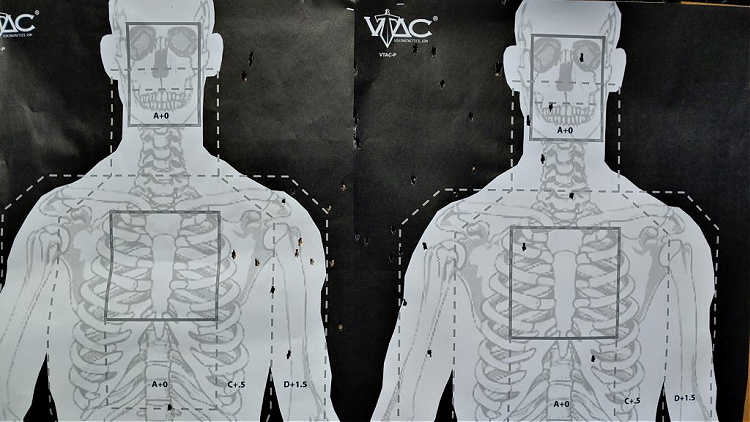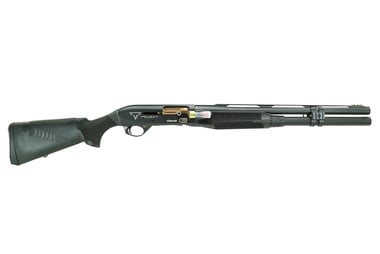Media Mayhem—Can shotguns hit two targets with one shot?

Movie Madness is all about finding the truth behind tropes regarding guns, gear, knives, tactics, and more from the world of fiction. We explore tropes from video games, movies, tv, and whatever other media comes our way. In our first edition of the truth about tropes, we are going to look at an old video game shooter myth about shotguns. This one goes all the way back to Doom. It’s spread since then, and notably, landing multiple hits with one shotgun blast has been a popular enough trope to become an achievement in Doom 3, Rise of the Tomb Raider, and The Last of Us.

We all know that shotguns work through the spread of the pellets from an individual shotshell. Pellet accountability is a big thing in home defense and the tactical use of shotguns. A single stray pellet can kill an innocent person, and that is why patterning, careful shot placement, and training are critical in shotgun deployment.

The question is, can you use a shotgun to purposefully hit two man-sized targets in a defensive situation?
How practical is it, and what load and range is it effective at?
If it is possible, is it practical?
Our goal is to find out.
Shotguns, Ammo, and Test Parameters
For this experiment, I am using my favorite Benelli M4 shotgun. It’s loaded down with a cylinder bore choke, and the barrel is 18.5 inches long. The M4 is an all-around excellent shotgun for tactical use, and it typically finds its way into the hands of everyone from SWAT cops to SAS commandos. It’s a favorite of first-person shooters and an all-around sexy shotgun.

Ammo wise, I am using nothing but buckshot, and I have a range backpack full of buckshot to experiment with. For this test, I’m using 00, 0, No 1, and No 4 buckshot loads from various brands. I’m using VTAC targets and placing them side by side. My plan is to measure each group after each shot to find out just how wide a spread you can get so we could see the effective range of spread each load has. This allows me to measure just how far the targets can be apart and still be affected by the blast.

Science Time
Science was not my favorite subject. To be fair, none of them were my favorite. That’s why I joined the Marines instead of the Air Force. However, I’m going to attempt an experiment that doesn’t involve crayons. I have my ammo, my gun, and my target. All that’s left to discuss is range.
In video games, shotguns can hit two or three bad guys from all of two feet away. In real life, a shotgun doesn’t spread that far that fast. I’m going to start at 25 yards, and after firing one round of each load, I’ll move forward 5 yards. My point of aim will be sitting right between each target. This will be a single round elimination.

The testing criteria is simple. Fire one shot, unload, show clear, then go downrange to mark and measure where the pellets land. If a load fails to spread far enough to hit each target, it will be eliminated and will not be tested at the next yard line.
Let’s get to it.
The 25 Yard Line
Number 4
Number 4 was an impressive load at 25 yards and landed pellets on both targets in an impressive way. This includes several shots to the head and torso. The spread was a mighty 23 inches from left to the right.

Number 1
The Number 1 buckshot load hit each target with authority but didn’t strike the vital zones nearly as much as the number 4 at this range. The total spread was 20 inches left to right.
0
Single Aught or 0, buckshot loads worked at this range, but only four pellets hit the two targets, and none landed in the vital zone. The spread was 16 inches total.

00
Double Aught or 00, buckshot failed and only hit the between the targets and the right target.
The 20 Yard Line
Number 4
Number 4 again succeeded in hitting both targets with hits in the vital zones. The spread was 13 inches.

Number 1
The number 1 load worked the best at twenty yards with two more pellets in the vital zones than number 4. The spread was 15 inches.
0
The load failed to spread to both targets, with pellets hitting the left target and the center.

The 15 Yard Line
Number 4
The Number 4 load at 15 yards spread to both targets but scored no vital hits and spread 10 inches.

Number 1
The Number 1 load hit each target at 15 yards but scored no vital hits with a spread of 11 inches.

The 10 Yard Line
At ten yards, neither the Number 1 or Number 4 load spread between each target.

Shotguns, Spread, and Tropes
The conclusion is simple, yes it works, but not to the effect that video games show. At 25 and 20 yards, shotguns could theoretically hit two bad guys with one load. The thing is, the bad guys have to be sitting close with little room between them. Your best bet is two guys down a 25-yard long hallway coming at you standing side by side which is an unlikely scenario. However, even if you have that scenario, is it more efficient than just firing twice? Is it practical?

I think it’s evident that no, it’s not a practical technique worth training for. The only vital hits were scored at 20 and 25 yards, and when it worked at closer ranges, the shots were mostly in the arms and shoulders of the targets.

Interestingly enough, the United States military experimented with an interesting choke during the Vietnam war. It’s known as a duckbill choke, and the idea is to change the spread from vertical to horizontal and increase the chance of landing an effective hit on moving targets or even multiple targets.
It does spread the shot more horizontally, but practical use and testing showed the intended effect didn’t open the spread up enough to be useful.
How Could It Work?
We need bigger shotguns! Loaded with bigger shells! Something like a four gauge could be an efficient weapon at dispersing enough shot to hit multiple targets in an efficient way. However, that kind of weapon would need to be tripod-mounted and possibly crew-served. The more I talk about it, the more I like it.

Oh Benelli you beautiful Minx – Courtesy Taran Tactical
Anyway, back on the subject. The tactic of scoring two or even more hits with a shotgun is far from practical, but it is possible with the right load and at the right range.
Buy your shotgun magazines at the Warehouse!
Be sure to watch GunMag TV too.
Follow GunMag Warehouse on Instagram for daily updates: @gunmagwarehouse.
Travis Pike is a former Marine Machine Gunner, a lifelong firearms enthusiast, and now a regular guy who likes to shoot, write, and find ways to combine the two. He holds an NRA certification as a Basic Pistol Instructor and is the world’s Okayest firearm’s instructor.



